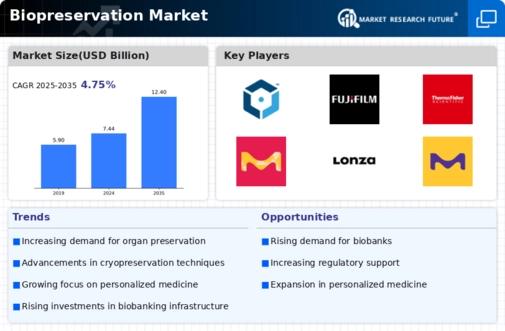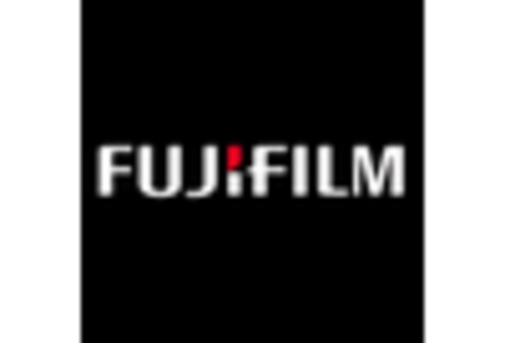-
FACTOR ANALYSIS
-
\r\n\r\n\r\nValue chain Analysis
-
\r\n\r\n\r\nPorter's
-
Five Forces Analysis
-
\r\n\r\n\r\nBargaining Power of Suppliers
-
\r\n\r\n\r\nBargaining
-
Power of Buyers
-
\r\n\r\n\r\nThreat of New Entrants
-
\r\n\r\n\r\nThreat
-
of Substitutes
-
\r\n\r\n\r\nIntensity of Rivalry
-
\r\n\r\n\r\n\r\n\r\nCOVID-19
-
Impact Analysis
-
\r\n\r\n\r\nMarket Impact Analysis
-
\r\n\r\n\r\nRegional
-
Impact
-
\r\n\r\n\r\nOpportunity and Threat Analysis
-
\r\n\r\n\r\n\r\n\r\n\r\n\r\n\r\n\r\nBiopreservation
-
Market, BY Application (USD Billion)
-
\r\n\r\n\r\nCell and
-
Tissue Culture
-
\r\n\r\n\r\nGene and Drug Therapy
-
\r\n\r\n\r\nClinical
-
Applications
-
\r\n\r\n\r\nRegenerative Medicine
-
\r\n\r\n\r\n\r\n\r\nBiopreservation
-
Market, BY Product Type (USD Billion)
-
\r\n\r\n\r\nBiopreservation
-
Media
-
\r\n\r\n\r\nFreezers
-
\r\n\r\n\r\nCryogenic Storage
-
Systems
-
\r\n\r\n\r\nAccessories
-
\r\n\r\n\r\n\r\n\r\nBiopreservation
-
Market, BY End User (USD Billion)
-
\r\n\r\n\r\nBiotechnology
-
Companies
-
\r\n\r\n\r\nPharmaceutical Companies
-
\r\n\r\n\r\nResearch
-
Institutions
-
\r\n\r\n\r\nHospitals and Clinics
-
\r\n\r\n\r\n\r\n\r\nBiopreservation
-
Market, BY Storage Type (USD Billion)
-
\r\n\r\n\r\nCryopreservation
-
\r\n\r\n\r\nControlled
-
Rate Freezing
-
\r\n\r\n\r\nUltra-Low Temperature Storage
-
\r\n\r\n\r\n\r\n\r\nBiopreservation
-
Market, BY Regional (USD Billion)
-
\r\n\r\n\r\nNorth America
-
\r\n\r\n\r\nUS
-
\r\n\r\n\r\nCanada
-
\r\n\r\n\r\n\r\n\r\nEurope
-
\r\n\r\n\r\nGermany
-
\r\n\r\n\r\nUK
-
\r\n\r\n\r\nFrance
-
\r\n\r\n\r\nRussia
-
\r\n\r\n\r\nItaly
-
\r\n\r\n\r\nSpain
-
\r\n\r\n\r\nRest
-
of Europe
-
\r\n\r\n\r\n\r\n\r\nAPAC
-
\r\n\r\n\r\nChina
-
\r\n\r\n\r\nIndia
-
\r\n\r\n\r\nJapan
-
\r\n\r\n\r\nSouth
-
Korea
-
\r\n\r\n\r\nMalaysia
-
\r\n\r\n\r\nThailand
-
\r\n\r\n\r\nIndonesia
-
\r\n\r\n\r\nRest
-
of APAC
-
\r\n\r\n\r\n\r\n\r\nSouth America
-
\r\n\r\n\r\nBrazil
-
\r\n\r\n\r\nMexico
-
\r\n\r\n\r\nArgentina
-
\r\n\r\n\r\nRest
-
of South America
-
\r\n\r\n\r\n\r\n\r\nMEA
-
\r\n\r\n\r\nGCC
-
Countries
-
\r\n\r\n\r\nSouth Africa
-
\r\n\r\n\r\nRest
-
of MEA
-
\r\n\r\n\r\n\r\n\r\n\r\n\r\n\r\n\r\nCompetitive
-
Landscape
-
\r\n\r\n\r\nOverview
-
\r\n\r\n\r\nCompetitive
-
Analysis
-
\r\n\r\n\r\nMarket share Analysis
-
\r\n\r\n\r\nMajor
-
Growth Strategy in the Biopreservation Market
-
\r\n\r\n\r\nCompetitive
-
Benchmarking
-
\r\n\r\n\r\nLeading Players in Terms of Number of Developments
-
in the Biopreservation Market
-
\r\n\r\n\r\nKey developments and growth
-
strategies
-
\r\n\r\n\r\nNew Product Launch/Service Deployment
-
\r\n\r\n\r\nMerger
-
& Acquisitions
-
\r\n\r\n\r\nJoint Ventures
-
\r\n\r\n\r\n\r\n\r\nMajor
-
Players Financial Matrix
-
\r\n\r\n\r\nSales and Operating Income
-
\r\n\r\n\r\nMajor
-
Players R&D Expenditure. 2023
-
\r\n\r\n\r\n\r\n\r\n\r\n\r\nCompany
-
Profiles
-
\r\n\r\n\r\nPanasonic Healthcare
-
\r\n\r\n\r\nFinancial
-
Overview
-
\r\n\r\n\r\nProducts Offered
-
\r\n\r\n\r\nKey
-
Developments
-
\r\n\r\n\r\nSWOT Analysis
-
\r\n\r\n\r\nKey
-
Strategies
-
\r\n\r\n\r\n\r\n\r\nFujifilm Irvine Scientific
-
\r\n\r\n\r\nFinancial
-
Overview
-
\r\n\r\n\r\nProducts Offered
-
\r\n\r\n\r\nKey
-
Developments
-
\r\n\r\n\r\nSWOT Analysis
-
\r\n\r\n\r\nKey
-
Strategies
-
\r\n\r\n\r\n\r\n\r\nSartorius AG
-
\r\n\r\n\r\nFinancial
-
Overview
-
\r\n\r\n\r\nProducts Offered
-
\r\n\r\n\r\nKey
-
Developments
-
\r\n\r\n\r\nSWOT Analysis
-
\r\n\r\n\r\nKey
-
Strategies
-
\r\n\r\n\r\n\r\n\r\nCryoport, Inc.
-
\r\n\r\n\r\nFinancial
-
Overview
-
\r\n\r\n\r\nProducts Offered
-
\r\n\r\n\r\nKey
-
Developments
-
\r\n\r\n\r\nSWOT Analysis
-
\r\n\r\n\r\nKey
-
Strategies
-
\r\n\r\n\r\n\r\n\r\nThermo Fisher Scientific
-
\r\n\r\n\r\nFinancial
-
Overview
-
\r\n\r\n\r\nProducts Offered
-
\r\n\r\n\r\nKey
-
Developments
-
\r\n\r\n\r\nSWOT Analysis
-
\r\n\r\n\r\nKey
-
Strategies
-
\r\n\r\n\r\n\r\n\r\nMerck KGaA
-
\r\n\r\n\r\nFinancial
-
Overview
-
\r\n\r\n\r\nProducts Offered
-
\r\n\r\n\r\nKey
-
Developments
-
\r\n\r\n\r\nSWOT Analysis
-
\r\n\r\n\r\nKey
-
Strategies
-
\r\n\r\n\r\n\r\n\r\nBiolife Solutions
-
\r\n\r\n\r\nFinancial
-
Overview
-
\r\n\r\n\r\nProducts Offered
-
\r\n\r\n\r\nKey
-
Developments
-
\r\n\r\n\r\nSWOT Analysis
-
\r\n\r\n\r\nKey
-
Strategies
-
\r\n\r\n\r\n\r\n\r\nDanaher Corporation
-
\r\n\r\n\r\nFinancial
-
Overview
-
\r\n\r\n\r\nProducts Offered
-
\r\n\r\n\r\nKey
-
Developments
-
\r\n\r\n\r\nSWOT Analysis
-
\r\n\r\n\r\nKey
-
Strategies
-
\r\n\r\n\r\n\r\n\r\nVWR International
-
\r\n\r\n\r\nFinancial
-
Overview
-
\r\n\r\n\r\nProducts Offered
-
\r\n\r\n\r\nKey
-
Developments
-
\r\n\r\n\r\nSWOT Analysis
-
\r\n\r\n\r\nKey
-
Strategies
-
\r\n\r\n\r\n\r\n\r\nSigmaAldrich
-
\r\n\r\n\r\nFinancial
-
Overview
-
\r\n\r\n\r\nProducts Offered
-
\r\n\r\n\r\nKey
-
Developments
-
\r\n\r\n\r\nSWOT Analysis
-
\r\n\r\n\r\nKey
-
Strategies
-
\r\n\r\n\r\n\r\n\r\nCelerion
-
\r\n\r\n\r\nFinancial
-
Overview
-
\r\n\r\n\r\nProducts Offered
-
\r\n\r\n\r\nKey
-
Developments
-
\r\n\r\n\r\nSWOT Analysis
-
\r\n\r\n\r\nKey
-
Strategies
-
\r\n\r\n\r\n\r\n\r\nWuxi AppTec
-
\r\n\r\n\r\nFinancial
-
Overview
-
\r\n\r\n\r\nProducts Offered
-
\r\n\r\n\r\nKey
-
Developments
-
\r\n\r\n\r\nSWOT Analysis
-
\r\n\r\n\r\nKey
-
Strategies
-
\r\n\r\n\r\n\r\n\r\nRevvity
-
\r\n\r\n\r\nFinancial
-
Overview
-
\r\n\r\n\r\nProducts Offered
-
\r\n\r\n\r\nKey
-
Developments
-
\r\n\r\n\r\nSWOT Analysis
-
\r\n\r\n\r\nKey
-
Strategies
-
\r\n\r\n\r\n\r\n\r\nLonza Group
-
\r\n\r\n\r\nFinancial
-
Overview
-
\r\n\r\n\r\nProducts Offered
-
\r\n\r\n\r\nKey
-
Developments
-
\r\n\r\n\r\nSWOT Analysis
-
\r\n\r\n\r\nKey
-
Strategies
-
\r\n\r\n\r\n\r\n\r\nStreck, Inc.
-
\r\n\r\n\r\nFinancial
-
Overview
-
\r\n\r\n\r\nProducts Offered
-
\r\n\r\n\r\nKey
-
Developments
-
\r\n\r\n\r\nSWOT Analysis
-
\r\n\r\n\r\nKey
-
Strategies
-
\r\n\r\n\r\n\r\n\r\n\r\n\r\nAppendix
-
\r\n\r\n\r\nReferences
-
\r\n\r\n\r\nRelated
-
Reports
-
\r\n\r\n\r\n\r\n\r\nLIST Of tables
-
\r\n\r\n\r\nLIST
-
OF ASSUMPTIONS
-
\r\n\r\n\r\nNorth America Biopreservation Market SIZE
-
ESTIMATES & FORECAST, BY APPLICATION, 2019-2035 (USD Billions)
-
\r\n\r\n\r\nNorth
-
America Biopreservation Market SIZE ESTIMATES & FORECAST, BY PRODUCT TYPE, 2019-2035
-
(USD Billions)
-
\r\n\r\n\r\nNorth America Biopreservation Market SIZE
-
ESTIMATES & FORECAST, BY END USER, 2019-2035 (USD Billions)
-
\r\n\r\n\r\nNorth
-
America Biopreservation Market SIZE ESTIMATES & FORECAST, BY STORAGE TYPE, 2019-2035
-
(USD Billions)
-
\r\n\r\n\r\nNorth America Biopreservation Market SIZE
-
ESTIMATES & FORECAST, BY REGIONAL, 2019-2035 (USD Billions)
-
\r\n\r\n\r\nUS
-
Biopreservation Market SIZE ESTIMATES & FORECAST, BY APPLICATION, 2019-2035
-
(USD Billions)
-
\r\n\r\n\r\nUS Biopreservation Market SIZE ESTIMATES
-
& FORECAST, BY PRODUCT TYPE, 2019-2035 (USD Billions)
-
\r\n\r\n\r\nUS
-
Biopreservation Market SIZE ESTIMATES & FORECAST, BY END USER, 2019-2035 (USD
-
Billions)
-
\r\n\r\n\r\nUS Biopreservation Market SIZE ESTIMATES &
-
FORECAST, BY STORAGE TYPE, 2019-2035 (USD Billions)
-
\r\n\r\n\r\nUS
-
Biopreservation Market SIZE ESTIMATES & FORECAST, BY REGIONAL, 2019-2035 (USD
-
Billions)
-
\r\n\r\n\r\nCanada Biopreservation Market SIZE ESTIMATES
-
& FORECAST, BY APPLICATION, 2019-2035 (USD Billions)
-
\r\n\r\n\r\nCanada
-
Biopreservation Market SIZE ESTIMATES & FORECAST, BY PRODUCT TYPE, 2019-2035
-
(USD Billions)
-
\r\n\r\n\r\nCanada Biopreservation Market SIZE ESTIMATES
-
& FORECAST, BY END USER, 2019-2035 (USD Billions)
-
\r\n\r\n\r\nCanada
-
Biopreservation Market SIZE ESTIMATES & FORECAST, BY STORAGE TYPE, 2019-2035
-
(USD Billions)
-
\r\n\r\n\r\nCanada Biopreservation Market SIZE ESTIMATES
-
& FORECAST, BY REGIONAL, 2019-2035 (USD Billions)
-
\r\n\r\n\r\nEurope
-
Biopreservation Market SIZE ESTIMATES & FORECAST, BY APPLICATION, 2019-2035
-
(USD Billions)
-
\r\n\r\n\r\nEurope Biopreservation Market SIZE ESTIMATES
-
& FORECAST, BY PRODUCT TYPE, 2019-2035 (USD Billions)
-
\r\n\r\n\r\nEurope
-
Biopreservation Market SIZE ESTIMATES & FORECAST, BY END USER, 2019-2035 (USD
-
Billions)
-
\r\n\r\n\r\nEurope Biopreservation Market SIZE ESTIMATES
-
& FORECAST, BY STORAGE TYPE, 2019-2035 (USD Billions)
-
\r\n\r\n\r\nEurope
-
Biopreservation Market SIZE ESTIMATES & FORECAST, BY REGIONAL, 2019-2035 (USD
-
Billions)
-
\r\n\r\n\r\nGermany Biopreservation Market SIZE ESTIMATES
-
& FORECAST, BY APPLICATION, 2019-2035 (USD Billions)
-
\r\n\r\n\r\nGermany
-
Biopreservation Market SIZE ESTIMATES & FORECAST, BY PRODUCT TYPE, 2019-2035
-
(USD Billions)
-
\r\n\r\n\r\nGermany Biopreservation Market SIZE ESTIMATES
-
& FORECAST, BY END USER, 2019-2035 (USD Billions)
-
\r\n\r\n\r\nGermany
-
Biopreservation Market SIZE ESTIMATES & FORECAST, BY STORAGE TYPE, 2019-2035
-
(USD Billions)
-
\r\n\r\n\r\nGermany Biopreservation Market SIZE ESTIMATES
-
& FORECAST, BY REGIONAL, 2019-2035 (USD Billions)
-
\r\n\r\n\r\nUK
-
Biopreservation Market SIZE ESTIMATES & FORECAST, BY APPLICATION, 2019-2035
-
(USD Billions)
-
\r\n\r\n\r\nUK Biopreservation Market SIZE ESTIMATES
-
& FORECAST, BY PRODUCT TYPE, 2019-2035 (USD Billions)
-
\r\n\r\n\r\nUK
-
Biopreservation Market SIZE ESTIMATES & FORECAST, BY END USER, 2019-2035 (USD
-
Billions)
-
\r\n\r\n\r\nUK Biopreservation Market SIZE ESTIMATES &
-
FORECAST, BY STORAGE TYPE, 2019-2035 (USD Billions)
-
\r\n\r\n\r\nUK
-
Biopreservation Market SIZE ESTIMATES & FORECAST, BY REGIONAL, 2019-2035 (USD
-
Billions)
-
\r\n\r\n\r\nFrance Biopreservation Market SIZE ESTIMATES
-
& FORECAST, BY APPLICATION, 2019-2035 (USD Billions)
-
\r\n\r\n\r\nFrance
-
Biopreservation Market SIZE ESTIMATES & FORECAST, BY PRODUCT TYPE, 2019-2035
-
(USD Billions)
-
\r\n\r\n\r\nFrance Biopreservation Market SIZE ESTIMATES
-
& FORECAST, BY END USER, 2019-2035 (USD Billions)
-
\r\n\r\n\r\nFrance
-
Biopreservation Market SIZE ESTIMATES & FORECAST, BY STORAGE TYPE, 2019-2035
-
(USD Billions)
-
\r\n\r\n\r\nFrance Biopreservation Market SIZE ESTIMATES
-
& FORECAST, BY REGIONAL, 2019-2035 (USD Billions)
-
\r\n\r\n\r\nRussia
-
Biopreservation Market SIZE ESTIMATES & FORECAST, BY APPLICATION, 2019-2035
-
(USD Billions)
-
\r\n\r\n\r\nRussia Biopreservation Market SIZE ESTIMATES
-
& FORECAST, BY PRODUCT TYPE, 2019-2035 (USD Billions)
-
\r\n\r\n\r\nRussia
-
Biopreservation Market SIZE ESTIMATES & FORECAST, BY END USER, 2019-2035 (USD
-
Billions)
-
\r\n\r\n\r\nRussia Biopreservation Market SIZE ESTIMATES
-
& FORECAST, BY STORAGE TYPE, 2019-2035 (USD Billions)
-
\r\n\r\n\r\nRussia
-
Biopreservation Market SIZE ESTIMATES & FORECAST, BY REGIONAL, 2019-2035 (USD
-
Billions)
-
\r\n\r\n\r\nItaly Biopreservation Market SIZE ESTIMATES
-
& FORECAST, BY APPLICATION, 2019-2035 (USD Billions)
-
\r\n\r\n\r\nItaly
-
Biopreservation Market SIZE ESTIMATES & FORECAST, BY PRODUCT TYPE, 2019-2035
-
(USD Billions)
-
\r\n\r\n\r\nItaly Biopreservation Market SIZE ESTIMATES
-
& FORECAST, BY END USER, 2019-2035 (USD Billions)
-
\r\n\r\n\r\nItaly
-
Biopreservation Market SIZE ESTIMATES & FORECAST, BY STORAGE TYPE, 2019-2035
-
(USD Billions)
-
\r\n\r\n\r\nItaly Biopreservation Market SIZE ESTIMATES
-
& FORECAST, BY REGIONAL, 2019-2035 (USD Billions)
-
\r\n\r\n\r\nSpain
-
Biopreservation Market SIZE ESTIMATES & FORECAST, BY APPLICATION, 2019-2035
-
(USD Billions)
-
\r\n\r\n\r\nSpain Biopreservation Market SIZE ESTIMATES
-
& FORECAST, BY PRODUCT TYPE, 2019-2035 (USD Billions)
-
\r\n\r\n\r\nSpain
-
Biopreservation Market SIZE ESTIMATES & FORECAST, BY END USER, 2019-2035 (USD
-
Billions)
-
\r\n\r\n\r\nSpain Biopreservation Market SIZE ESTIMATES
-
& FORECAST, BY STORAGE TYPE, 2019-2035 (USD Billions)
-
\r\n\r\n\r\nSpain
-
Biopreservation Market SIZE ESTIMATES & FORECAST, BY REGIONAL, 2019-2035 (USD
-
Billions)
-
\r\n\r\n\r\nRest of Europe Biopreservation Market SIZE
-
ESTIMATES & FORECAST, BY APPLICATION, 2019-2035 (USD Billions)
-
\r\n\r\n\r\nRest
-
of Europe Biopreservation Market SIZE ESTIMATES & FORECAST, BY PRODUCT TYPE,
-
\r\n\r\n\r\nRest of Europe Biopreservation
-
Market SIZE ESTIMATES & FORECAST, BY END USER, 2019-2035 (USD Billions)
-
\r\n\r\n\r\nRest
-
of Europe Biopreservation Market SIZE ESTIMATES & FORECAST, BY STORAGE TYPE,
-
\r\n\r\n\r\nRest of Europe Biopreservation
-
Market SIZE ESTIMATES & FORECAST, BY REGIONAL, 2019-2035 (USD Billions)
-
\r\n\r\n\r\nAPAC
-
Biopreservation Market SIZE ESTIMATES & FORECAST, BY APPLICATION, 2019-2035
-
(USD Billions)
-
\r\n\r\n\r\nAPAC Biopreservation Market SIZE ESTIMATES
-
& FORECAST, BY PRODUCT TYPE, 2019-2035 (USD Billions)
-
\r\n\r\n\r\nAPAC
-
Biopreservation Market SIZE ESTIMATES & FORECAST, BY END USER, 2019-2035 (USD
-
Billions)
-
\r\n\r\n\r\nAPAC Biopreservation Market SIZE ESTIMATES
-
& FORECAST, BY STORAGE TYPE, 2019-2035 (USD Billions)
-
\r\n\r\n\r\nAPAC
-
Biopreservation Market SIZE ESTIMATES & FORECAST, BY REGIONAL, 2019-2035 (USD
-
Billions)
-
\r\n\r\n\r\nChina Biopreservation Market SIZE ESTIMATES
-
& FORECAST, BY APPLICATION, 2019-2035 (USD Billions)
-
\r\n\r\n\r\nChina
-
Biopreservation Market SIZE ESTIMATES & FORECAST, BY PRODUCT TYPE, 2019-2035
-
(USD Billions)
-
\r\n\r\n\r\nChina Biopreservation Market SIZE ESTIMATES
-
& FORECAST, BY END USER, 2019-2035 (USD Billions)
-
\r\n\r\n\r\nChina
-
Biopreservation Market SIZE ESTIMATES & FORECAST, BY STORAGE TYPE, 2019-2035
-
(USD Billions)
-
\r\n\r\n\r\nChina Biopreservation Market SIZE ESTIMATES
-
& FORECAST, BY REGIONAL, 2019-2035 (USD Billions)
-
\r\n\r\n\r\nIndia
-
Biopreservation Market SIZE ESTIMATES & FORECAST, BY APPLICATION, 2019-2035
-
(USD Billions)
-
\r\n\r\n\r\nIndia Biopreservation Market SIZE ESTIMATES
-
& FORECAST, BY PRODUCT TYPE, 2019-2035 (USD Billions)
-
\r\n\r\n\r\nIndia
-
Biopreservation Market SIZE ESTIMATES & FORECAST, BY END USER, 2019-2035 (USD
-
Billions)
-
\r\n\r\n\r\nIndia Biopreservation Market SIZE ESTIMATES
-
& FORECAST, BY STORAGE TYPE, 2019-2035 (USD Billions)
-
\r\n\r\n\r\nIndia
-
Biopreservation Market SIZE ESTIMATES & FORECAST, BY REGIONAL, 2019-2035 (USD
-
Billions)
-
\r\n\r\n\r\nJapan Biopreservation Market SIZE ESTIMATES
-
& FORECAST, BY APPLICATION, 2019-2035 (USD Billions)
-
\r\n\r\n\r\nJapan
-
Biopreservation Market SIZE ESTIMATES & FORECAST, BY PRODUCT TYPE, 2019-2035
-
(USD Billions)
-
\r\n\r\n\r\nJapan Biopreservation Market SIZE ESTIMATES
-
& FORECAST, BY END USER, 2019-2035 (USD Billions)
-
\r\n\r\n\r\nJapan
-
Biopreservation Market SIZE ESTIMATES & FORECAST, BY STORAGE TYPE, 2019-2035
-
(USD Billions)
-
\r\n\r\n\r\nJapan Biopreservation Market SIZE ESTIMATES
-
& FORECAST, BY REGIONAL, 2019-2035 (USD Billions)
-
\r\n\r\n\r\nSouth
-
Korea Biopreservation Market SIZE ESTIMATES & FORECAST, BY APPLICATION, 2019-2035
-
(USD Billions)
-
\r\n\r\n\r\nSouth Korea Biopreservation Market SIZE
-
ESTIMATES & FORECAST, BY PRODUCT TYPE, 2019-2035 (USD Billions)
-
\r\n\r\n\r\nSouth
-
Korea Biopreservation Market SIZE ESTIMATES & FORECAST, BY END USER, 2019-2035
-
(USD Billions)
-
\r\n\r\n\r\nSouth Korea Biopreservation Market SIZE
-
ESTIMATES & FORECAST, BY STORAGE TYPE, 2019-2035 (USD Billions)
-
\r\n\r\n\r\nSouth
-
Korea Biopreservation Market SIZE ESTIMATES & FORECAST, BY REGIONAL, 2019-2035
-
(USD Billions)
-
\r\n\r\n\r\nMalaysia Biopreservation Market SIZE ESTIMATES
-
& FORECAST, BY APPLICATION, 2019-2035 (USD Billions)
-
\r\n\r\n\r\nMalaysia
-
Biopreservation Market SIZE ESTIMATES & FORECAST, BY PRODUCT TYPE, 2019-2035
-
(USD Billions)
-
\r\n\r\n\r\nMalaysia Biopreservation Market SIZE ESTIMATES
-
& FORECAST, BY END USER, 2019-2035 (USD Billions)
-
\r\n\r\n\r\nMalaysia
-
Biopreservation Market SIZE ESTIMATES & FORECAST, BY STORAGE TYPE, 2019-2035
-
(USD Billions)
-
\r\n\r\n\r\nMalaysia Biopreservation Market SIZE ESTIMATES
-
& FORECAST, BY REGIONAL, 2019-2035 (USD Billions)
-
\r\n\r\n\r\nThailand
-
Biopreservation Market SIZE ESTIMATES & FORECAST, BY APPLICATION, 2019-2035
-
(USD Billions)
-
\r\n\r\n\r\nThailand Biopreservation Market SIZE ESTIMATES
-
& FORECAST, BY PRODUCT TYPE, 2019-2035 (USD Billions)
-
\r\n\r\n\r\nThailand
-
Biopreservation Market SIZE ESTIMATES & FORECAST, BY END USER, 2019-2035 (USD
-
Billions)
-
\r\n\r\n\r\nThailand Biopreservation Market SIZE ESTIMATES
-
& FORECAST, BY STORAGE TYPE, 2019-2035 (USD Billions)
-
\r\n\r\n\r\nThailand
-
Biopreservation Market SIZE ESTIMATES & FORECAST, BY REGIONAL, 2019-2035 (USD
-
Billions)
-
\r\n\r\n\r\nIndonesia Biopreservation Market SIZE ESTIMATES
-
& FORECAST, BY APPLICATION, 2019-2035 (USD Billions)
-
\r\n\r\n\r\nIndonesia
-
Biopreservation Market SIZE ESTIMATES & FORECAST, BY PRODUCT TYPE, 2019-2035
-
(USD Billions)
-
\r\n\r\n\r\nIndonesia Biopreservation Market SIZE
-
ESTIMATES & FORECAST, BY END USER, 2019-2035 (USD Billions)
-
\r\n\r\n\r\nIndonesia
-
Biopreservation Market SIZE ESTIMATES & FORECAST, BY STORAGE TYPE, 2019-2035
-
(USD Billions)
-
\r\n\r\n\r\nIndonesia Biopreservation Market SIZE
-
ESTIMATES & FORECAST, BY REGIONAL, 2019-2035 (USD Billions)
-
\r\n\r\n\r\nRest
-
of APAC Biopreservation Market SIZE ESTIMATES & FORECAST, BY APPLICATION, 2019-2035
-
(USD Billions)
-
\r\n\r\n\r\nRest of APAC Biopreservation Market SIZE
-
ESTIMATES & FORECAST, BY PRODUCT TYPE, 2019-2035 (USD Billions)
-
\r\n\r\n\r\nRest
-
of APAC Biopreservation Market SIZE ESTIMATES & FORECAST, BY END USER, 2019-2035
-
(USD Billions)
-
\r\n\r\n\r\nRest of APAC Biopreservation Market SIZE
-
ESTIMATES & FORECAST, BY STORAGE TYPE, 2019-2035 (USD Billions)
-
\r\n\r\n\r\nRest
-
of APAC Biopreservation Market SIZE ESTIMATES & FORECAST, BY REGIONAL, 2019-2035
-
(USD Billions)
-
\r\n\r\n\r\nSouth America Biopreservation Market SIZE
-
ESTIMATES & FORECAST, BY APPLICATION, 2019-2035 (USD Billions)
-
\r\n\r\n\r\nSouth
-
America Biopreservation Market SIZE ESTIMATES & FORECAST, BY PRODUCT TYPE, 2019-2035
-
(USD Billions)
-
\r\n\r\n\r\nSouth America Biopreservation Market SIZE
-
ESTIMATES & FORECAST, BY END USER, 2019-2035 (USD Billions)
-
\r\n\r\n\r\nSouth
-
America Biopreservation Market SIZE ESTIMATES & FORECAST, BY STORAGE TYPE, 2019-2035
-
(USD Billions)
-
\r\n\r\n\r\nSouth America Biopreservation Market SIZE
-
ESTIMATES & FORECAST, BY REGIONAL, 2019-2035 (USD Billions)
-
\r\n\r\n\r\nBrazil
-
Biopreservation Market SIZE ESTIMATES & FORECAST, BY APPLICATION, 2019-2035
-
(USD Billions)
-
\r\n\r\n\r\nBrazil Biopreservation Market SIZE ESTIMATES
-
& FORECAST, BY PRODUCT TYPE, 2019-2035 (USD Billions)
-
\r\n\r\n\r\nBrazil
-
Biopreservation Market SIZE ESTIMATES & FORECAST, BY END USER, 2019-2035 (USD
-
Billions)
-
\r\n\r\n\r\nBrazil Biopreservation Market SIZE ESTIMATES
-
& FORECAST, BY STORAGE TYPE, 2019-2035 (USD Billions)
-
\r\n\r\n\r\nBrazil
-
Biopreservation Market SIZE ESTIMATES & FORECAST, BY REGIONAL, 2019-2035 (USD
-
Billions)
-
\r\n\r\n\r\nMexico Biopreservation Market SIZE ESTIMATES
-
& FORECAST, BY APPLICATION, 2019-2035 (USD Billions)
-
\r\n\r\n\r\nMexico
-
Biopreservation Market SIZE ESTIMATES & FORECAST, BY PRODUCT TYPE, 2019-2035
-
(USD Billions)
-
\r\n\r\n\r\nMexico Biopreservation Market SIZE ESTIMATES
-
& FORECAST, BY END USER, 2019-2035 (USD Billions)
-
\r\n\r\n\r\nMexico
-
Biopreservation Market SIZE ESTIMATES & FORECAST, BY STORAGE TYPE, 2019-2035
-
(USD Billions)
-
\r\n\r\n\r\nMexico Biopreservation Market SIZE ESTIMATES
-
& FORECAST, BY REGIONAL, 2019-2035 (USD Billions)
-
\r\n\r\n\r\nArgentina
-
Biopreservation Market SIZE ESTIMATES & FORECAST, BY APPLICATION, 2019-2035
-
(USD Billions)
-
\r\n\r\n\r\nArgentina Biopreservation Market SIZE
-
ESTIMATES & FORECAST, BY PRODUCT TYPE, 2019-2035 (USD Billions)
-
\r\n\r\n\r\nArgentina
-
Biopreservation Market SIZE ESTIMATES & FORECAST, BY END USER, 2019-2035 (USD
-
Billions)
-
\r\n\r\n\r\nArgentina Biopreservation Market SIZE ESTIMATES
-
& FORECAST, BY STORAGE TYPE, 2019-2035 (USD Billions)
-
\r\n\r\n\r\nArgentina
-
Biopreservation Market SIZE ESTIMATES & FORECAST, BY REGIONAL, 2019-2035 (USD
-
Billions)
-
\r\n\r\n\r\nRest of South America Biopreservation Market
-
SIZE ESTIMATES & FORECAST, BY APPLICATION, 2019-2035 (USD Billions)
-
\r\n\r\n\r\nRest
-
of South America Biopreservation Market SIZE ESTIMATES & FORECAST, BY PRODUCT
-
TYPE, 2019-2035 (USD Billions)
-
\r\n\r\n\r\nRest of South America
-
Biopreservation Market SIZE ESTIMATES & FORECAST, BY END USER, 2019-2035 (USD
-
Billions)
-
\r\n\r\n\r\nRest of South America Biopreservation Market
-
SIZE ESTIMATES & FORECAST, BY STORAGE TYPE, 2019-2035 (USD Billions)
-
\r\n\r\n\r\nRest
-
of South America Biopreservation Market SIZE ESTIMATES & FORECAST, BY REGIONAL,
-
\r\n\r\n\r\nMEA Biopreservation Market SIZE
-
ESTIMATES & FORECAST, BY APPLICATION, 2019-2035 (USD Billions)
-
\r\n\r\n\r\nMEA
-
Biopreservation Market SIZE ESTIMATES & FORECAST, BY PRODUCT TYPE, 2019-2035
-
(USD Billions)
-
\r\n\r\n\r\nMEA Biopreservation Market SIZE ESTIMATES
-
& FORECAST, BY END USER, 2019-2035 (USD Billions)
-
\r\n\r\n\r\nMEA
-
Biopreservation Market SIZE ESTIMATES & FORECAST, BY STORAGE TYPE, 2019-2035
-
(USD Billions)
-
\r\n\r\n\r\nMEA Biopreservation Market SIZE ESTIMATES
-
& FORECAST, BY REGIONAL, 2019-2035 (USD Billions)
-
\r\n\r\n\r\nGCC
-
Countries Biopreservation Market SIZE ESTIMATES & FORECAST, BY APPLICATION,
-
\r\n\r\n\r\nGCC Countries Biopreservation
-
Market SIZE ESTIMATES & FORECAST, BY PRODUCT TYPE, 2019-2035 (USD Billions)
-
\r\n\r\n\r\nGCC
-
Countries Biopreservation Market SIZE ESTIMATES & FORECAST, BY END USER, 2019-2035
-
(USD Billions)
-
\r\n\r\n\r\nGCC Countries Biopreservation Market SIZE
-
ESTIMATES & FORECAST, BY STORAGE TYPE, 2019-2035 (USD Billions)
-
\r\n\r\n\r\nGCC
-
Countries Biopreservation Market SIZE ESTIMATES & FORECAST, BY REGIONAL, 2019-2035
-
(USD Billions)
-
\r\n\r\n\r\nSouth Africa Biopreservation Market SIZE
-
ESTIMATES & FORECAST, BY APPLICATION, 2019-2035 (USD Billions)
-
\r\n\r\n\r\nSouth
-
Africa Biopreservation Market SIZE ESTIMATES & FORECAST, BY PRODUCT TYPE, 2019-2035
-
(USD Billions)
-
\r\n\r\n\r\nSouth Africa Biopreservation Market SIZE
-
ESTIMATES & FORECAST, BY END USER, 2019-2035 (USD Billions)
-
\r\n\r\n\r\nSouth
-
Africa Biopreservation Market SIZE ESTIMATES & FORECAST, BY STORAGE TYPE, 2019-2035
-
(USD Billions)
-
\r\n\r\n\r\nSouth Africa Biopreservation Market SIZE
-
ESTIMATES & FORECAST, BY REGIONAL, 2019-2035 (USD Billions)
-
\r\n\r\n\r\nRest
-
of MEA Biopreservation Market SIZE ESTIMATES & FORECAST, BY APPLICATION, 2019-2035
-
(USD Billions)
-
\r\n\r\n\r\nRest of MEA Biopreservation Market SIZE
-
ESTIMATES & FORECAST, BY PRODUCT TYPE, 2019-2035 (USD Billions)
-
\r\n\r\n\r\nRest
-
of MEA Biopreservation Market SIZE ESTIMATES & FORECAST, BY END USER, 2019-2035
-
(USD Billions)
-
\r\n\r\n\r\nRest of MEA Biopreservation Market SIZE
-
ESTIMATES & FORECAST, BY STORAGE TYPE, 2019-2035 (USD Billions)
-
\r\n\r\n\r\nRest
-
of MEA Biopreservation Market SIZE ESTIMATES & FORECAST, BY REGIONAL, 2019-2035
-
(USD Billions)
-
\r\n\r\n\r\nPRODUCT LAUNCH/PRODUCT DEVELOPMENT/APPROVAL
-
\r\n\r\n\r\nACQUISITION/PARTNERSHIP
-
\r\n\r\n\r\nLIST
-
Of figures
-
\r\n\r\n\r\nMARKET SYNOPSIS
-
\r\n\r\n\r\nNORTH
-
AMERICA BIOPRESERVATION MARKET ANALYSIS
-
\r\n\r\n\r\nUS BIOPRESERVATION
-
MARKET ANALYSIS BY APPLICATION
-
\r\n\r\n\r\nUS BIOPRESERVATION MARKET
-
ANALYSIS BY PRODUCT TYPE
-
\r\n\r\n\r\nUS BIOPRESERVATION MARKET ANALYSIS
-
BY END USER
-
\r\n\r\n\r\nUS BIOPRESERVATION MARKET ANALYSIS BY STORAGE
-
TYPE
-
\r\n\r\n\r\nUS BIOPRESERVATION MARKET ANALYSIS BY REGIONAL
-
\r\n\r\n\r\nCANADA
-
BIOPRESERVATION MARKET ANALYSIS BY APPLICATION
-
\r\n\r\n\r\nCANADA
-
BIOPRESERVATION MARKET ANALYSIS BY PRODUCT TYPE
-
\r\n\r\n\r\nCANADA
-
BIOPRESERVATION MARKET ANALYSIS BY END USER
-
\r\n\r\n\r\nCANADA BIOPRESERVATION
-
MARKET ANALYSIS BY STORAGE TYPE
-
\r\n\r\n\r\nCANADA BIOPRESERVATION
-
MARKET ANALYSIS BY REGIONAL
-
\r\n\r\n\r\nEUROPE BIOPRESERVATION MARKET
-
ANALYSIS
-
\r\n\r\n\r\nGERMANY BIOPRESERVATION MARKET ANALYSIS BY APPLICATION
-
\r\n\r\n\r\nGERMANY
-
BIOPRESERVATION MARKET ANALYSIS BY PRODUCT TYPE
-
\r\n\r\n\r\nGERMANY
-
BIOPRESERVATION MARKET ANALYSIS BY END USER
-
\r\n\r\n\r\nGERMANY BIOPRESERVATION
-
MARKET ANALYSIS BY STORAGE TYPE
-
\r\n\r\n\r\nGERMANY BIOPRESERVATION
-
MARKET ANALYSIS BY REGIONAL
-
\r\n\r\n\r\nUK BIOPRESERVATION MARKET
-
ANALYSIS BY APPLICATION
-
\r\n\r\n\r\nUK BIOPRESERVATION MARKET ANALYSIS
-
BY PRODUCT TYPE
-
\r\n\r\n\r\nUK BIOPRESERVATION MARKET ANALYSIS BY
-
END USER
-
\r\n\r\n\r\nUK BIOPRESERVATION MARKET ANALYSIS BY STORAGE
-
TYPE
-
\r\n\r\n\r\nUK BIOPRESERVATION MARKET ANALYSIS BY REGIONAL
-
\r\n\r\n\r\nFRANCE
-
BIOPRESERVATION MARKET ANALYSIS BY APPLICATION
-
\r\n\r\n\r\nFRANCE
-
BIOPRESERVATION MARKET ANALYSIS BY PRODUCT TYPE
-
\r\n\r\n\r\nFRANCE
-
BIOPRESERVATION MARKET ANALYSIS BY END USER
-
\r\n\r\n\r\nFRANCE BIOPRESERVATION
-
MARKET ANALYSIS BY STORAGE TYPE
-
\r\n\r\n\r\nFRANCE BIOPRESERVATION
-
MARKET ANALYSIS BY REGIONAL
-
\r\n\r\n\r\nRUSSIA BIOPRESERVATION MARKET
-
ANALYSIS BY APPLICATION
-
\r\n\r\n\r\nRUSSIA BIOPRESERVATION MARKET
-
ANALYSIS BY PRODUCT TYPE
-
\r\n\r\n\r\nRUSSIA BIOPRESERVATION MARKET
-
ANALYSIS BY END USER
-
\r\n\r\n\r\nRUSSIA BIOPRESERVATION MARKET ANALYSIS
-
BY STORAGE TYPE
-
\r\n\r\n\r\nRUSSIA BIOPRESERVATION MARKET ANALYSIS
-
BY REGIONAL
-
\r\n\r\n\r\nITALY BIOPRESERVATION MARKET ANALYSIS BY
-
APPLICATION
-
\r\n\r\n\r\nITALY BIOPRESERVATION MARKET ANALYSIS BY
-
PRODUCT TYPE
-
\r\n\r\n\r\nITALY BIOPRESERVATION MARKET ANALYSIS BY
-
END USER
-
\r\n\r\n\r\nITALY BIOPRESERVATION MARKET ANALYSIS BY STORAGE
-
TYPE
-
\r\n\r\n\r\nITALY BIOPRESERVATION MARKET ANALYSIS BY REGIONAL
-
\r\n\r\n\r\nSPAIN
-
BIOPRESERVATION MARKET ANALYSIS BY APPLICATION
-
\r\n\r\n\r\nSPAIN
-
BIOPRESERVATION MARKET ANALYSIS BY PRODUCT TYPE
-
\r\n\r\n\r\nSPAIN
-
BIOPRESERVATION MARKET ANALYSIS BY END USER
-
\r\n\r\n\r\nSPAIN BIOPRESERVATION
-
MARKET ANALYSIS BY STORAGE TYPE
-
\r\n\r\n\r\nSPAIN BIOPRESERVATION
-
MARKET ANALYSIS BY REGIONAL
-
\r\n\r\n\r\nREST OF EUROPE BIOPRESERVATION
-
MARKET ANALYSIS BY APPLICATION
-
\r\n\r\n\r\nREST OF EUROPE BIOPRESERVATION
-
MARKET ANALYSIS BY PRODUCT TYPE
-
\r\n\r\n\r\nREST OF EUROPE BIOPRESERVATION
-
MARKET ANALYSIS BY END USER
-
\r\n\r\n\r\nREST OF EUROPE BIOPRESERVATION
-
MARKET ANALYSIS BY STORAGE TYPE
-
\r\n\r\n\r\nREST OF EUROPE BIOPRESERVATION
-
MARKET ANALYSIS BY REGIONAL
-
\r\n\r\n\r\nAPAC BIOPRESERVATION MARKET
-
ANALYSIS
-
\r\n\r\n\r\nCHINA BIOPRESERVATION MARKET ANALYSIS BY APPLICATION
-
\r\n\r\n\r\nCHINA
-
BIOPRESERVATION MARKET ANALYSIS BY PRODUCT TYPE
-
\r\n\r\n\r\nCHINA
-
BIOPRESERVATION MARKET ANALYSIS BY END USER
-
\r\n\r\n\r\nCHINA BIOPRESERVATION
-
MARKET ANALYSIS BY STORAGE TYPE
-
\r\n\r\n\r\nCHINA BIOPRESERVATION
-
MARKET ANALYSIS BY REGIONAL
-
\r\n\r\n\r\nINDIA BIOPRESERVATION MARKET
-
ANALYSIS BY APPLICATION
-
\r\n\r\n\r\nINDIA BIOPRESERVATION MARKET
-
ANALYSIS BY PRODUCT TYPE
-
\r\n\r\n\r\nINDIA BIOPRESERVATION MARKET
-
ANALYSIS BY END USER
-
\r\n\r\n\r\nINDIA BIOPRESERVATION MARKET ANALYSIS
-
BY STORAGE TYPE
-
\r\n\r\n\r\nINDIA BIOPRESERVATION MARKET ANALYSIS
-
BY REGIONAL
-
\r\n\r\n\r\nJAPAN BIOPRESERVATION MARKET ANALYSIS BY
-
APPLICATION
-
\r\n\r\n\r\nJAPAN BIOPRESERVATION MARKET ANALYSIS BY
-
PRODUCT TYPE
-
\r\n\r\n\r\nJAPAN BIOPRESERVATION MARKET ANALYSIS BY
-
END USER
-
\r\n\r\n\r\nJAPAN BIOPRESERVATION MARKET ANALYSIS BY STORAGE
-
TYPE
-
\r\n\r\n\r\nJAPAN BIOPRESERVATION MARKET ANALYSIS BY REGIONAL
-
\r\n\r\n\r\nSOUTH
-
KOREA BIOPRESERVATION MARKET ANALYSIS BY APPLICATION
-
\r\n\r\n\r\nSOUTH
-
KOREA BIOPRESERVATION MARKET ANALYSIS BY PRODUCT TYPE
-
\r\n\r\n\r\nSOUTH
-
KOREA BIOPRESERVATION MARKET ANALYSIS BY END USER
-
\r\n\r\n\r\nSOUTH
-
KOREA BIOPRESERVATION MARKET ANALYSIS BY STORAGE TYPE
-
\r\n\r\n\r\nSOUTH
-
KOREA BIOPRESERVATION MARKET ANALYSIS BY REGIONAL
-
\r\n\r\n\r\nMALAYSIA
-
BIOPRESERVATION MARKET ANALYSIS BY APPLICATION
-
\r\n\r\n\r\nMALAYSIA
-
BIOPRESERVATION MARKET ANALYSIS BY PRODUCT TYPE
-
\r\n\r\n\r\nMALAYSIA
-
BIOPRESERVATION MARKET ANALYSIS BY END USER
-
\r\n\r\n\r\nMALAYSIA
-
BIOPRESERVATION MARKET ANALYSIS BY STORAGE TYPE
-
\r\n\r\n\r\nMALAYSIA
-
BIOPRESERVATION MARKET ANALYSIS BY REGIONAL
-
\r\n\r\n\r\nTHAILAND
-
BIOPRESERVATION MARKET ANALYSIS BY APPLICATION
-
\r\n\r\n\r\nTHAILAND
-
BIOPRESERVATION MARKET ANALYSIS BY PRODUCT TYPE
-
\r\n\r\n\r\nTHAILAND
-
BIOPRESERVATION MARKET ANALYSIS BY END USER
-
\r\n\r\n\r\nTHAILAND
-
BIOPRESERVATION MARKET ANALYSIS BY STORAGE TYPE
-
\r\n\r\n\r\nTHAILAND
-
BIOPRESERVATION MARKET ANALYSIS BY REGIONAL
-
\r\n\r\n\r\nINDONESIA
-
BIOPRESERVATION MARKET ANALYSIS BY APPLICATION
-
\r\n\r\n\r\nINDONESIA
-
BIOPRESERVATION MARKET ANALYSIS BY PRODUCT TYPE
-
\r\n\r\n\r\nINDONESIA
-
BIOPRESERVATION MARKET ANALYSIS BY END USER
-
\r\n\r\n\r\nINDONESIA
-
BIOPRESERVATION MARKET ANALYSIS BY STORAGE TYPE
-
\r\n\r\n\r\nINDONESIA
-
BIOPRESERVATION MARKET ANALYSIS BY REGIONAL
-
\r\n\r\n\r\nREST OF APAC
-
BIOPRESERVATION MARKET ANALYSIS BY APPLICATION
-
\r\n\r\n\r\nREST OF
-
APAC BIOPRESERVATION MARKET ANALYSIS BY PRODUCT TYPE
-
\r\n\r\n\r\nREST
-
OF APAC BIOPRESERVATION MARKET ANALYSIS BY END USER
-
\r\n\r\n\r\nREST
-
OF APAC BIOPRESERVATION MARKET ANALYSIS BY STORAGE TYPE
-
\r\n\r\n\r\nREST
-
OF APAC BIOPRESERVATION MARKET ANALYSIS BY REGIONAL
-
\r\n\r\n\r\nSOUTH
-
AMERICA BIOPRESERVATION MARKET ANALYSIS
-
\r\n\r\n\r\nBRAZIL BIOPRESERVATION
-
MARKET ANALYSIS BY APPLICATION
-
\r\n\r\n\r\nBRAZIL BIOPRESERVATION
-
MARKET ANALYSIS BY PRODUCT TYPE
-
\r\n\r\n\r\nBRAZIL BIOPRESERVATION
-
MARKET ANALYSIS BY END USER
-
\r\n\r\n\r\nBRAZIL BIOPRESERVATION MARKET
-
ANALYSIS BY STORAGE TYPE
-
\r\n\r\n\r\nBRAZIL BIOPRESERVATION MARKET
-
ANALYSIS BY REGIONAL
-
\r\n\r\n\r\nMEXICO BIOPRESERVATION MARKET ANALYSIS
-
BY APPLICATION
-
\r\n\r\n\r\nMEXICO BIOPRESERVATION MARKET ANALYSIS
-
BY PRODUCT TYPE
-
\r\n\r\n\r\nMEXICO BIOPRESERVATION MARKET ANALYSIS
-
BY END USER
-
\r\n\r\n\r\nMEXICO BIOPRESERVATION MARKET ANALYSIS BY
-
STORAGE TYPE
-
\r\n\r\n\r\nMEXICO BIOPRESERVATION MARKET ANALYSIS BY
-
REGIONAL
-
\r\n\r\n\r\nARGENTINA BIOPRESERVATION MARKET ANALYSIS BY
-
APPLICATION
-
\r\n\r\n\r\nARGENTINA BIOPRESERVATION MARKET ANALYSIS
-
BY PRODUCT TYPE
-
\r\n\r\n\r\nARGENTINA BIOPRESERVATION MARKET ANALYSIS
-
BY END USER
-
\r\n\r\n\r\nARGENTINA BIOPRESERVATION MARKET ANALYSIS
-
BY STORAGE TYPE
-
\r\n\r\n\r\nARGENTINA BIOPRESERVATION MARKET ANALYSIS
-
BY REGIONAL
-
\r\n\r\n\r\nREST OF SOUTH AMERICA BIOPRESERVATION MARKET
-
ANALYSIS BY APPLICATION
-
\r\n\r\n\r\nREST OF SOUTH AMERICA BIOPRESERVATION
-
MARKET ANALYSIS BY PRODUCT TYPE
-
\r\n\r\n\r\nREST OF SOUTH AMERICA
-
BIOPRESERVATION MARKET ANALYSIS BY END USER
-
\r\n\r\n\r\nREST OF SOUTH
-
AMERICA BIOPRESERVATION MARKET ANALYSIS BY STORAGE TYPE
-
\r\n\r\n\r\nREST
-
OF SOUTH AMERICA BIOPRESERVATION MARKET ANALYSIS BY REGIONAL
-
\r\n\r\n\r\nMEA
-
BIOPRESERVATION MARKET ANALYSIS
-
\r\n\r\n\r\nGCC COUNTRIES BIOPRESERVATION
-
MARKET ANALYSIS BY APPLICATION
-
\r\n\r\n\r\nGCC COUNTRIES BIOPRESERVATION
-
MARKET ANALYSIS BY PRODUCT TYPE
-
\r\n\r\n\r\nGCC COUNTRIES BIOPRESERVATION
-
MARKET ANALYSIS BY END USER
-
\r\n\r\n\r\nGCC COUNTRIES BIOPRESERVATION
-
MARKET ANALYSIS BY STORAGE TYPE
-
\r\n\r\n\r\nGCC COUNTRIES BIOPRESERVATION
-
MARKET ANALYSIS BY REGIONAL
-
\r\n\r\n\r\nSOUTH AFRICA BIOPRESERVATION
-
MARKET ANALYSIS BY APPLICATION
-
\r\n\r\n\r\nSOUTH AFRICA BIOPRESERVATION
-
MARKET ANALYSIS BY PRODUCT TYPE
-
\r\n\r\n\r\nSOUTH AFRICA BIOPRESERVATION
-
MARKET ANALYSIS BY END USER
-
\r\n\r\n\r\nSOUTH AFRICA BIOPRESERVATION
-
MARKET ANALYSIS BY STORAGE TYPE
-
\r\n\r\n\r\nSOUTH AFRICA BIOPRESERVATION
-
MARKET ANALYSIS BY REGIONAL
-
\r\n\r\n\r\nREST OF MEA BIOPRESERVATION
-
MARKET ANALYSIS BY APPLICATION
-
\r\n\r\n\r\nREST OF MEA BIOPRESERVATION
-
MARKET ANALYSIS BY PRODUCT TYPE
-
\r\n\r\n\r\nREST OF MEA BIOPRESERVATION
-
MARKET ANALYSIS BY END USER
-
\r\n\r\n\r\nREST OF MEA BIOPRESERVATION
-
MARKET ANALYSIS BY STORAGE TYPE
-
\r\n\r\n\r\nREST OF MEA BIOPRESERVATION
-
MARKET ANALYSIS BY REGIONAL
-
\r\n\r\n\r\nKEY BUYING CRITERIA OF BIOPRESERVATION
-
MARKET
-
\r\n\r\n\r\nRESEARCH PROCESS OF MRFR
-
\r\n\r\n\r\nDRO
-
ANALYSIS OF BIOPRESERVATION MARKET
-
\r\n\r\n\r\nDRIVERS IMPACT ANALYSIS:
-
BIOPRESERVATION MARKET
-
\r\n\r\n\r\nRESTRAINTS IMPACT ANALYSIS: BIOPRESERVATION
-
MARKET
-
\r\n\r\n\r\nSUPPLY / VALUE CHAIN: BIOPRESERVATION MARKET
-
\r\n\r\n\r\nBIOPRESERVATION
-
MARKET, BY APPLICATION, 2025 (% SHARE)
-
\r\n\r\n\r\nBIOPRESERVATION
-
MARKET, BY APPLICATION, 2019 TO 2035 (USD Billions)
-
\r\n\r\n\r\nBIOPRESERVATION
-
MARKET, BY PRODUCT TYPE, 2025 (% SHARE)
-
\r\n\r\n\r\nBIOPRESERVATION
-
MARKET, BY PRODUCT TYPE, 2019 TO 2035 (USD Billions)
-
\r\n\r\n\r\nBIOPRESERVATION
-
MARKET, BY END USER, 2025 (% SHARE)
-
\r\n\r\n\r\nBIOPRESERVATION MARKET,
-
BY END USER, 2019 TO 2035 (USD Billions)
-
\r\n\r\n\r\nBIOPRESERVATION
-
MARKET, BY STORAGE TYPE, 2025 (% SHARE)
-
\r\n\r\n\r\nBIOPRESERVATION
-
MARKET, BY STORAGE TYPE, 2019 TO 2035 (USD Billions)
-
\r\n\r\n\r\nBIOPRESERVATION
-
MARKET, BY REGIONAL, 2025 (% SHARE)
-
\r\n\r\n\r\nBIOPRESERVATION MARKET,
-
BY REGIONAL, 2019 TO 2035 (USD Billions)
-
\r\n\r\n\r\nBENCHMARKING
-
OF MAJOR COMPETITORS
-
\r\n\r\n











Leave a Comment